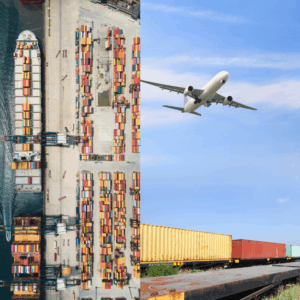
In this article, we explore everything from what a freight bill is to how freight bill auditing, freight bill factoring, and real-time analytics shape modern freight operations. You’ll also learn how ExFreight’s digital freight forwarding platform simplifies access to air freight instant rates, LCL cargo rates, and LTL quotes, giving you a more innovative way to manage your logistics.
What is a Freight Bill and Why Does It Matter
A freight bill, also known as a freight invoice, is a financial document issued by a carrier or freight forwarder to a shipper. It outlines the charges related to transporting goods and serves as a formal request for payment. Unlike the bill of lading, which is a legal contract between the shipper and carrier, the freight bill focuses on the billing aspect of the transaction. It’s designed to itemize every detail involved in the shipment, from the weight and dimensions of the cargo to the services performed and the associated costs.

The Role of Freight Bill Numbers, Auditing, and Factoring
Each freight bill is assigned to a unique identifier, commonly referred to as a freight bill number or PRO number. This is not just a reference credit; it serves as a tracking tool used by carriers and shippers to monitor the status of a shipment and its associated charges. It links back to the bill of lading, allowing for easy traceability throughout the logistics process.
To ensure that the charges reflected on a freight bill are accurate, many businesses conduct freight bill audits to verify the accuracy of these charges. This process involves carefully reviewing the invoice for discrepancies such as incorrect rates, misapplied surcharges, or duplicate billing. Automated freight bill auditing software has become increasingly popular, particularly among businesses that manage high volumes of shipping. These tools help reduce overpayment, improve budgeting, and maintain financial accuracy in logistics operations.

Logistics Intelligence and Freight Analytics in Action
Logistics intelligence refers to the application of data-driven strategies to manage shipping and transportation more effectively. With the help of software and integrated platforms, companies can collect, analyze, and interpret logistics data to make smarter decisions. Freight analytics plays a central role in this process. It helps identify trends in delivery performance, carrier reliability, freight cost fluctuations, and route optimization.
For example, businesses can use freight analytics to evaluate which carriers consistently deliver on time or to determine whether accessorial charges are increasing disproportionately. This type of insight supports proactive decision-making and ultimately contributes to an efficient supply chain. When logistics intelligence is combined with a detailed understanding of freight bills, companies gain complete visibility into the operational and financial aspects of their freight activities.

A Digital Shift: Freight Technology in Practice
The evolution of freight technology has led to the rise of digital freight forwarding, a model that emphasizes automation, transparency, and real-time access to data. Traditional shipping processes, which often involve manual paperwork and slow communication, have given way to systems that allow users to log in, get instant quotes, book shipments, and track cargo all in one place. This level of digitization not only improves speed and accuracy but also helps companies avoid common billing mistakes and delays.
Using ExFreight’s platform, for instance, users can input shipment details and instantly receive LCL cargo rates, air freight instant rates, and even spot rates for domestic shipments. The system considers dimensions, weight, and transit times, offering dynamic pricing based on current market conditions. Moreover, all this is done without the need for lengthy email threads or back-and-forth negotiations, which are common in traditional freight brokerage models.
The ability to view and manage freight documents online, including freight bills, landing bills, and insurance certificates, adds another layer of efficiency. This reduces errors in documentation and ensures that all parties have access to the same information in real-time. For businesses focused on maintaining an efficient supply chain, adopting digital freight technology is no longer optional.
Frequently Asked Questions
How do I get a shipping rate with ExFreight?
If you have an account with ExFreight, you can log in and click on “Get a Quote” to generate instant pricing for your shipment. If you don’t have an account yet, you can create one online or speak with a sales representative to explore rate options.
What are destination terminal fees, and when do they apply?
Destination terminal fees are charges applied by the terminal at the destination port or airport to unload your cargo. If your shipment is booked under a door-to-port service, these fees are not included and must be paid by the consignee. However, if you choose a door-to-door service with ExFreight, these charges are covered in your quoted rate.
What are the packaging requirements for international freight?
All cargo must be adequately packed in sealed boxes or crates. Loose or bagged items are not accepted unless shipped via small parcel service. For shipments involving multiple pieces, palletizing is mandatory, and items over 75 lbs. must be secured to a pallet. Additionally, international shipments must use ISPM 15 heat-treated wood, and air freight must comply with TSA banding requirements.
What tips do you have for first-time importers?
Understand your Incoterms and select shipping terms that provide you with control over customs and delivery. Classify your commodity accurately and verify the applicable duty rate. Ensure you have obtained any required permits and determine whether air or ocean freight is best suited to your needs. Finally, work with a customs broker; ExFreight provides this service for door-to-door shipments.
Freight bills are far more than just transactional documents—they are strategic tools that connect your financial, operational, and logistical systems. From the detailed breakdowns they provide to the role they play in auditing and cash flow management, freight bills lie at the core of effective freight and transport strategies. When enriched by logistics intelligence and freight analytics, they become key drivers of transparency, efficiency, and growth.
By leveraging platforms like ExFreight, businesses can simplify the process of quoting, booking, and tracking freight. Whether you’re managing domestic LTL shipments or international container loads, the combination of smart data and powerful digital tools ensures you stay ahead in a competitive global market. Ready to optimize your logistics operations? Open an ExFreight account today and experience shipping made simple.




Leave A Comment
You must be logged in to post a comment.